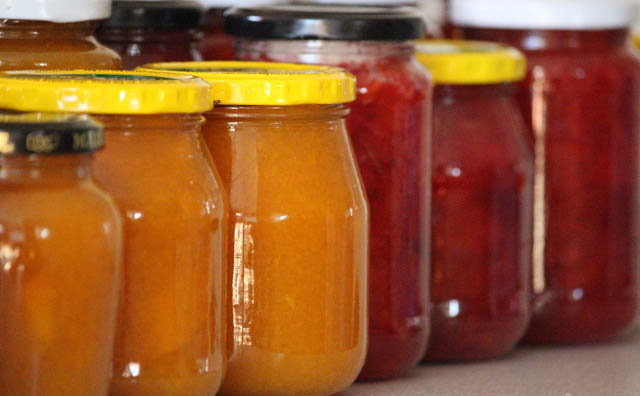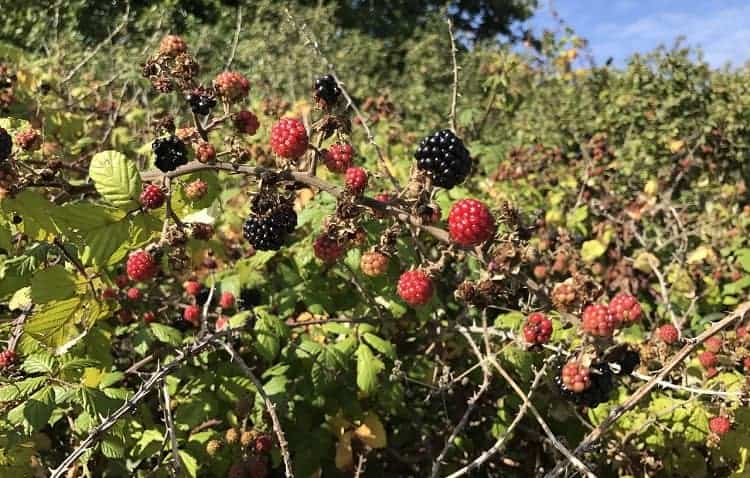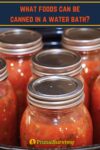Most people understand that not all foods can be processed using the water bath method, but many don’t know exactly which foods can be preserved this way. While water bath canning can only be used to preserve highly acidic or acidulated foods, its abilities extend far beyond simple jams and jellies.
Low-acid foods are not acidic enough to prevent the growth of harmful bacteria, so foods that are processed using a water bath must have a pH level of 4.6 or lower. There are occasions where adding citric acid, lemon juice, or vinegar is necessary to facilitate this process.
If you’re new to canning, review our full instructional guide to learn more about water bath canning. Otherwise, try adding some of these home-canned foods to your food storage.
1. Conserves
Conserves usually include two or more fruits and frequently contain raisins and/or nuts. Examples include peach-pineapple-orange conserves or fig conserves with walnuts. They have a thick, chunky texture and are traditionally eaten with meats and cheeses.
2. Fruit Butters
Fruit butters are made from fruit pulp and are cooked down slowly with sugar until thickened to a spreadable consistency. Fruit butters normally contain less sugar than other preserves and often include the addition of herbs and spices for added flavor.
3. Jams

Jam is made from crushed or chopped fruits and sugar that are cooked to a smooth consistency. Some jams have enough natural pectin, but others require the addition of acid or pectin. Berries usually make the best jams.
4. Jellies
Jellies are made by cooking fruits and extracting their juices. These fruit juices are then mixed with the perfect proportions of sugar, pectin, or acid to give them a firm shape. When jelly is cut, it quivers but holds its shape.
5. Marmalades
Marmalades are typically made with citrus fruits and usually contain soft, thin pieces of fruit or citrus peel evenly suspended in a transparent jelly. It’s most often eaten with breakfast breads like toast, biscuits, or scones.
6. Preserves
Similar to jams, preserves are made with large or whole pieces of fruit and are cooked in such a way that the fruit retains its texture and shape. Usually, a bright, translucent syrup surrounds the fruit, giving it a good consistency for spreading.
7. Fresh Fruits

Fresh fruits can be raw packed or hot packed and then submerged in hot syrup. Some fruits need to be treated to prevent darkening. This can be done with a solution of one gallon of water mixed with two tablespoons each of salt and vinegar, or a commercial ascorbic acid.
Sugar is not necessary when canning whole fruits, but it does improve the appearance and flavor and keeps your fruit firm. Recipes for light, medium, and heavy syrups are readily available and easy to find.
These are the most common fruits used in water bath canning:
- Apples
- Apricots
- Blackberries
- Blueberries
- Cherries
- Citrus fruits
- Crab apples
- Currants
- Dewberries
- Elderberries
- Figs
- Fruit cocktail
- Gooseberries
- Huckleberries
- Grapes
- Loganberries
- Loquats
- Mulberries
- Nectarines
- Peaches
- Pears
- Persimmons
- Plums
- Prunes
- Raspberries
- Rhubarb
8. Brandied Fruit
Brandied fruit is simply preserving your harvest by way of good quality brandy. Not only does the brandy act as a preserving agent, but it also enhances the flavor of your fruit as it ages.
Brandied fruit does not require any canning at all. However, water-bath canning your favorite brandied fruits is both quicker and more reliable. These brandied fruits make delicious desserts or meat accompaniments:
- Apricots
- Grapes
- Peaches
- Pears
- Plums
- Sweet cherries
Brandied fruits are also an excellent addition to baked goods using fruit. Brandy does, however, displace part of the syrup, so a more concentrated syrup recipe is required.
9. Fruit Salsas
Fruit salsas are a combination of fruit and pepper varieties for both a sweet and spicy flavor. They typically combine fresh fruit, chilis, onion varieties, and lime juice. Choose fruits with a similar texture to tomatoes, and various onion and chili flavors to explore tastes.
| Fruits | Peppers | Onions |
|---|---|---|
| Mango | Chili | White |
| Peach | Bell | Red |
| Pineapple | Banana | Green |
| Watermelon | Habanero | Shallots |
10. Fruit Purees
Fruit purees involve cooking fruits in a small amount of water and then mashing the fruit through a wire strainer. Sugar and/or lemon juice are added for additional flavor. This mixture is then heated to boiling and hot-packed into jars for processing.
11. Fruit Juices and Cordials
When the harvest is plenty, why not add some fruit juices or even some fruit syrup to the mix for a bit of variety? Juices and cordials offer a good source of vitamins to get through the winter months. Many fresh fruits are suitable for canning fruit juices
12. Fruit Syrups
Juices from your favorite fresh fruits can be turned into toppings for ice cream, pastries, or even pancakes.
- Apples
- Apricots
- Blackberries
- Cherries
- Currants
- Elderberries
- Grapes
- Grapefruits
- Peach
- Pear
- Pineapple
- Raspberries
- Strawberries
- Tomatoes
13. Pie Filling
Having a few quarts of pie filling on hand is a quick and easy way to whip up delicious pies just as quickly as you can roll out the crust.
Pie fillings combine your favorite fruits with Clear Jel as a thickening agent. This allows your filling to thicken to a proper consistency while also allowing the heat to penetrate and destroy the dangerous organisms.
Here are just a few of the most popular pie fillings you can water bath.
- Apple
- Apricot
- Blueberry
- Cherry
- Green tomato
- Mincemeat
- Peach
14. Sauerkraut
Sauerkraut is a fermented food made from cabbage. While cabbage is not suitable for canning under normal circumstances, once it’s been fermented you can process it through water bath canning. However, this does kill the probiotic advantage.
Additionally, canning sauerkraut is a long and drawn-out process. You must first let it ferment for at least three to six weeks before you can process it. Otherwise, it’s not safe.
15. Pickled Vegetables
Of course, pickles are the most common pickled vegetable preserved in brine or vinegar. However, there are plenty of other vegetables that you can pickle as well:
- Asparagus
- Green or yellow beans
- Beets
- Peppers
- Carrots
- Brussel sprouts
- Cauliflower
- Green tomatoes
- Marinated mushrooms – pickled mushroom recipe
- Okra
- Zucchini
16. Relishes
Technically, relish is any blend of vegetables, fruits, spices, and vinegar that usually accompany a number of meats. Relish ingredients are usually finely chopped and have a chunky texture.
Most people are familiar with hot dog relish as a condiment. However, there are many other popular relishes known to different regions of the world.
- Piccalilli
- Chayote and jicama
- Corn relish
- Curtido
- Mostarda
Relish can be made with just about any combination of fruit or vegetable, as long as you have vinegar and sugar.
17. Chutneys
Chutney is a type of relish, but its roots trace to Middle Eastern and Indian cuisine and it’s more on the spicy side. You’ll find a variety of common spices added to chutney to provide additional flavors:
- Allspice
- Chili pepper
- Cinnamon
- Coriander
- Ginger
- Nutmeg
- Tamarind
- Turmeric
Additionally, chutneys are cooked longer and, as such, their texture and consistency are a little softer. Most Western chutneys are slow-cooked over low heat for an extended period of time.
18. Whole or Diced Tomatoes
Take the most perfectly ripened blemish-free tomatoes and process them within 24 hours of harvest. Use them in stews and chilis, as well as your favorite Italian, Indian, and Mexican cuisine.
19. Tomato Paste
Tomato paste is a thick concentrate of tomatoes that adds a rich tomato flavor to anything. Roma tomatoes work best, and tomato paste is better preserved in smaller jars since a little goes a long way.
20. Tomato Sauce
Whether making unseasoned sauce for tomato-based meals, a seasoned sauce for pasta, or pizza sauce, water bath canning your own tomato sauce is truly a money saver.
21. Tomato Salsas
There’s nothing better than fresh salsa and pico de gallo in the summertime when everything is freshly picked from the garden. Canning your own salsa lets you preserve that fresh flavor year-round. Feel free to use ripe or green tomatoes.
Tomato-based salsas usually require the addition of at least 5% acidity like bottled lemon juice or vinegar. Do not use fresh lemon juice or homemade vinegar because the acidity level can vary.
22. Bloody Mary Mix or Tomato Cocktail Juice
If you like a cold Bloody Mary with fresh garden tomatoes on a hot summer afternoon, preserve that same fresh taste so you can enjoy it year-round.
23. Tomato-Based Sauces and Condiments
You’ll never go back to store-bought stuff again once you learn how easy it is to make and preserve your own condiments:
- Ketchup
- Barbecue sauce
- Chili sauce
- Taco sauce
- Steak sauce
Use Only Fresh Fruits and Vegetables
It’s essential to begin your canning process with only the freshest fruits and vegetables because they lose nearly half of their vitamins and nutrients within just a few short days of harvest, even when refrigerated.
Additionally, the canning process destroys up to one-half of Vitamins A and C, riboflavin, and thiamin. Attempting to preserve store-bought produce results in poor-quality, and often chemically treated, canned goods.
Obviously, growing your own is the surest method of self-reliance. But if you’re short on produce, try your local farmers’ market or farm store. These water bathed can goods are a great addition to any pantry.


